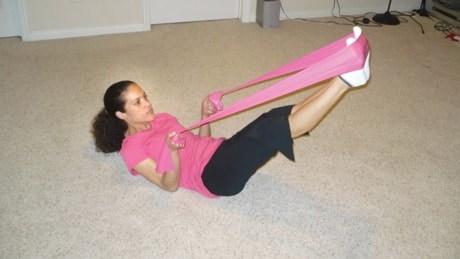They’re inexpensive. They’re portable. They’re safe. And, experts say, they provide a better muscle-building workout than do weight machines.
So it’s no wonder resistance bands are growing in popularity.
Resistance bands, also known as Thera-Bands, after a leading manufacturer, have long been used in rehabilitation.
“Every one of our patients has a Thera-Band tied to the back of their wheelchair,” said Barbara Swan, medical director for the Acute Rehabilitation Unit at West Penn Hospital in Pittsburgh.
“I also use them in the office. I call them a poor man’s Soloflex (a popular home exercise machine). They’re easy to use. They have different densities. They’re cheap.”
“I use bands for shoulder and ankle strengthening,” said Sean Kerr, a physical therapist for Panther Physical Therapy in Hampton, Pa. “They work better than weights because they are able to isolate the foot and ankle movements better.
“We give them to our patients to take home with them, so they can supplement what we do in rehab and they can recover more quickly,” Kerr said. “They’re small, they’re not cumbersome, they’re less expensive than weights.”
Elite athletes have largely replaced weights with resistance bands in their off-season conditioning programs.
“Research demonstrates that elastic resistance training provides as much benefit in strength gains as the use of more expensive and cumbersome weight-training equipment,” said strength and conditioning expert Phil Page, who has worked with football players for the New Orleans Saints and Seattle Seahawks.
And working with bands provides benefits that can’t be obtained from workouts with weights.
“Specific movement patterns relating to a sport. That’s when bands are really beneficial,” said Ron DeAngelo, director of sports performance training at the University of Pittsburgh Medical Center’s Center for Sports Medicine.
“We use them for lateral movements. If we really want to strengthen a person doing side-to-side movements, we’ll use the bands a lot.”
“If you are comparing bands with machines, bands are a lot more superior, because they allow you to deal with gravity, balance and ground reaction,” DeAngelo said. “Your body is always going to adapt better when it is in a position of function.”
A primary benefit of bands over weight machines is that bands “allow you to work groups of muscles rather than isolating muscles,” DeAngelo said.
“Elastic resistance allows you to exercise multiple joints and planes in a standing position (rather than seated on machines), thus bringing more core training into the same machine-based exercise,” said Page, who has written a book on resistance bands, “Strength Band Training” (Human Kinetics, 2011).
A major advantage of bands over barbells and dumbbells is safety.
“You don’t have to worry about dropping them on your toe,” Swan said.
Although bands can substitute for free weights in resistance training, experts say they work well together.
“We use bands in conjunction with barbells and dumbbells,” DeAngelo said. “For instance, bands enhance the squat a little bit more.”
Swan said she discourages the use of barbells in rehabilitation “because you can hurt yourself.” But West Penn uses hand weights in addition to bands.
Thera-Bands come in color-coded levels of resistance.
They can generally be purchased for less than $10. Packages with accessories cost more.
From Scripps Howard News Service.
